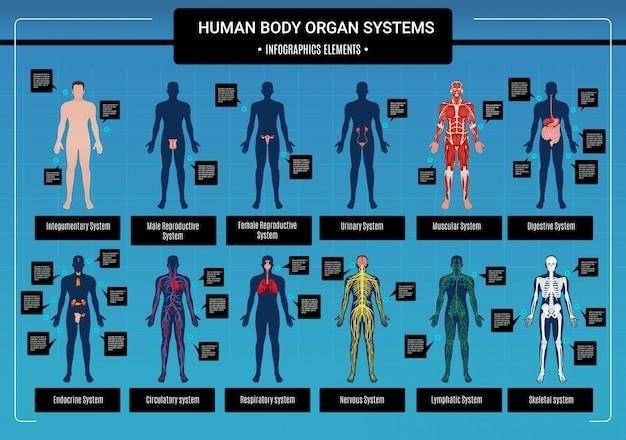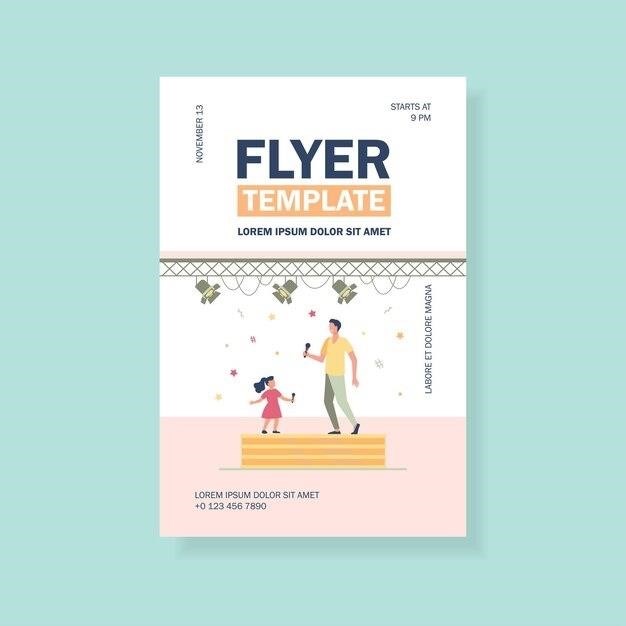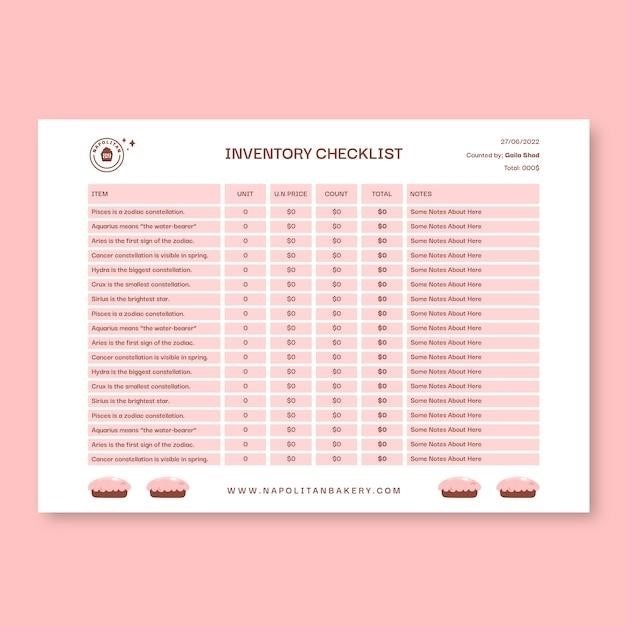Human Anatomy and Physiology Laboratory Manual, 13th Edition
The Human Anatomy & Physiology Laboratory Manual, 13th Edition is a comprehensive guide for students of human anatomy and physiology. This manual is designed to help students understand the complexities of the human body by providing a hands-on learning experience. The 13th edition offers a variety of features, including updated clinical applications and critical thinking questions, making it an essential resource for any student seeking to deepen their understanding of human anatomy and physiology.
Overview
The Human Anatomy & Physiology Laboratory Manual, 13th Edition, is a comprehensive guide designed for students taking human anatomy and physiology courses. This manual acts as a crucial companion to a textbook, providing a hands-on learning experience that reinforces theoretical concepts with practical applications. The 13th edition boasts numerous updates, including fresh clinical applications and engaging critical thinking questions, making it a valuable tool for students seeking a deeper understanding of the human body. The manual’s structure is designed to guide students through a series of laboratory exercises, each focusing on a specific anatomical or physiological system.
The Human Anatomy & Physiology Laboratory Manual is widely recognized for its user-friendly approach and clear presentation of information. It is a highly regarded resource for students who want to excel in their anatomy and physiology courses. The manual’s focus on practical application, coupled with its contemporary approach to anatomical and physiological concepts, ensures that students gain a solid foundation in this essential field of study.
The 13th edition of the Human Anatomy & Physiology Laboratory Manual reflects the latest advancements in the field, incorporating new research, technologies, and clinical practices. This comprehensive resource is a valuable tool for students seeking to gain a comprehensive and up-to-date understanding of human anatomy and physiology.
Key Features
The Human Anatomy & Physiology Laboratory Manual, 13th Edition, is packed with features designed to enhance student learning and engagement. The manual’s key features include⁚
- Comprehensive Coverage⁚ The manual covers all major body systems, providing a well-rounded understanding of human anatomy and physiology.
- Engaging Exercises⁚ Each laboratory exercise is designed to be interactive and hands-on, allowing students to apply theoretical knowledge to real-world scenarios.
- Clinical Applications⁚ The manual includes numerous clinical applications, demonstrating the relevance of anatomy and physiology to real-world healthcare practices.
- Critical Thinking Questions⁚ Each exercise is accompanied by critical thinking questions that encourage students to analyze data, draw conclusions, and apply their knowledge to new situations.
- Updated Content⁚ The 13th edition features updated content that reflects the latest advancements in anatomy, physiology, and medicine.
- Clear and Concise Writing⁚ The manual is written in a clear and concise style, making it easy for students to understand complex concepts.
- Full-Color Illustrations and Photographs⁚ The manual features numerous full-color illustrations and photographs, providing a visual understanding of anatomical structures and physiological processes.
- Online Resources⁚ The manual is accompanied by online resources, including additional exercises, animations, and videos.
These features make the Human Anatomy & Physiology Laboratory Manual, 13th Edition an essential resource for students seeking to master the fundamentals of human anatomy and physiology.
Cat Version
The Human Anatomy & Physiology Laboratory Manual, 13th Edition, is available in a Cat Version, offering a unique and valuable learning experience for students studying anatomy and physiology. This version utilizes the cat as a model organism to provide hands-on dissection experiences and comparative anatomical studies.
The Cat Version of the manual offers several benefits⁚
- Comparative Anatomy⁚ Studying the cat’s anatomy allows students to compare and contrast its structures with those of humans, providing a deeper understanding of the evolutionary relationships and functional adaptations of different species.
- Hands-On Learning⁚ The dissection exercises provide students with a practical and engaging way to learn about the structures and functions of various organ systems.
- Ethical Considerations⁚ The use of cats in laboratory exercises is carefully regulated and conducted with the utmost respect for animal welfare. The manual includes detailed ethical guidelines and procedures to ensure responsible and humane treatment of the animals.
- Cost-Effectiveness⁚ Using cats as a model organism can be more cost-effective than using human cadavers, making it a viable option for many institutions.
By utilizing the cat as a model organism, the Cat Version of the Human Anatomy & Physiology Laboratory Manual, 13th Edition provides a comprehensive and enriching learning experience, fostering a deeper understanding of anatomy, physiology, and the interconnectedness of life.
Laboratory Exercises
The Human Anatomy & Physiology Laboratory Manual, 13th Edition offers a comprehensive collection of laboratory exercises designed to enhance students’ understanding of human anatomy and physiology. These exercises are carefully crafted to provide a hands-on learning experience, allowing students to explore the intricate structures and functions of the human body in a practical and engaging manner.
The laboratory exercises in the manual cover a wide range of topics, including⁚
- Skeletal System⁚ Exercises focusing on identifying bones, articulations, and movements of the human skeleton, providing a foundation for understanding the structural basis of the body.
- Muscular System⁚ Exercises exploring the anatomy and function of muscles, including muscle contractions, types of muscle tissue, and their roles in movement.
- Nervous System⁚ Exercises investigating the structure and function of the nervous system, from the basic components of neurons to the complex pathways of sensory and motor systems.
- Cardiovascular System⁚ Exercises examining the heart, blood vessels, and blood circulation, including measuring blood pressure, heart rate, and analyzing electrocardiograms.
- Respiratory System⁚ Exercises exploring the anatomy and physiology of the respiratory system, including lung volume measurements, gas exchange, and the effects of exercise on breathing.
- Digestive System⁚ Exercises examining the anatomy and function of the digestive system, including the processes of digestion, absorption, and elimination.
- Urinary System⁚ Exercises investigating the anatomy and function of the urinary system, including kidney function, urine production, and the regulation of fluid balance.
- Endocrine System⁚ Exercises exploring the endocrine system, including the hormones produced by various glands and their effects on the body.
These laboratory exercises are designed to be engaging and interactive, providing students with a hands-on approach to learning and a deeper understanding of human anatomy and physiology.
Clinical Applications
The Human Anatomy & Physiology Laboratory Manual, 13th Edition goes beyond the basic principles of human anatomy and physiology, seamlessly integrating clinical applications into the learning process. This approach ensures students gain a deeper understanding of how their anatomical and physiological knowledge translates into real-world medical scenarios. The manual achieves this through⁚
- Real-World Case Studies⁚ The manual features engaging case studies that highlight real-world medical situations, allowing students to apply their anatomical and physiological knowledge to diagnose and understand patient conditions. These case studies provide a practical context for the concepts learned, making the learning process more relevant and engaging.
- Clinical Correlations⁚ Throughout the exercises, the manual emphasizes clinical correlations, explaining how anatomical structures and physiological processes relate to common medical conditions and procedures. This helps students understand the implications of their learning in a clinical context, fostering a deeper understanding of the practical application of their knowledge.
- Clinical Terminology⁚ The manual introduces students to essential clinical terminology, ensuring they are familiar with the language used in medical settings. This exposure to medical vocabulary prepares students for future studies and careers in healthcare.
- Integration of Medical Imaging⁚ The manual utilizes medical imaging techniques like X-rays, CT scans, and MRIs to illustrate anatomical structures and physiological processes. This exposure to medical imaging equips students with the skills to interpret and analyze medical images, a valuable skill in healthcare settings.
By integrating clinical applications, the Human Anatomy & Physiology Laboratory Manual, 13th Edition empowers students to connect theoretical knowledge with real-world medical practice, preparing them for future careers in healthcare.
Critical Thinking Questions
The Human Anatomy & Physiology Laboratory Manual, 13th Edition emphasizes critical thinking skills by incorporating a variety of stimulating questions that encourage students to delve deeper into the subject matter. These questions are designed to promote analysis, synthesis, and evaluation, going beyond simple recall of facts. By engaging with these questions, students are encouraged to⁚
- Analyze and Interpret Data⁚ The manual presents scenarios and data sets that require students to analyze and interpret information, drawing conclusions based on their understanding of anatomical and physiological principles. This process fosters critical thinking and problem-solving skills.
- Apply Concepts to New Situations⁚ The questions challenge students to apply their knowledge to novel situations, demonstrating their understanding of the concepts and their ability to think critically about how they relate to different contexts.
- Evaluate Evidence and Formulate Arguments⁚ The manual encourages students to evaluate evidence presented in case studies and research articles, forming well-supported arguments based on their analysis. This develops students’ critical thinking abilities, allowing them to make informed decisions and judgments.
- Explore Ethical Considerations⁚ Some questions address ethical considerations related to human anatomy and physiology, encouraging students to think critically about the implications of their studies in a broader societal context.
These critical thinking questions foster a deeper understanding of human anatomy and physiology, going beyond rote memorization and promoting intellectual curiosity. By engaging with these questions, students develop valuable critical thinking skills that are essential for success in any field, particularly in the healthcare profession.
Instructor Resources
The Human Anatomy & Physiology Laboratory Manual, 13th Edition provides a comprehensive suite of resources specifically tailored for instructors, ensuring a smooth and effective teaching experience. These resources aim to streamline the learning process and enhance the overall educational experience for both instructors and students. The instructor resources include⁚
- Instructor’s Manual⁚ This valuable resource provides instructors with detailed guidance on implementing the laboratory exercises, including answers to all critical thinking questions and suggestions for classroom discussions. It also offers alternative lab activities and assessment strategies to cater to diverse learning styles and preferences.
- Test Bank⁚ The test bank provides a wide range of exam questions, covering all key concepts and topics presented in the laboratory manual. These questions can be used to create comprehensive assessments, evaluate student understanding, and ensure mastery of essential learning objectives.
- PowerPoint Presentations⁚ The PowerPoint presentations offer a visually engaging and informative way to introduce and reinforce key concepts covered in each laboratory exercise. Instructors can utilize these presentations to enhance lectures, engage students in interactive discussions, and provide a clear and concise overview of the material.
- Image Bank⁚ The image bank provides a comprehensive collection of high-quality anatomical and physiological images that can be used for various purposes, including creating lectures, handouts, and visual aids for presentations. These images offer a rich visual resource for illustrating complex anatomical structures and physiological processes.
These instructor resources offer a valuable support system for educators, enabling them to effectively manage and enhance the learning experience for their students. By providing comprehensive guidance, assessment tools, and engaging visual aids, the instructor resources contribute significantly to a successful and enriching learning environment.
Student Resources
The Human Anatomy & Physiology Laboratory Manual, 13th Edition recognizes the importance of providing students with readily accessible resources to support their learning journey. These resources are designed to enhance understanding, promote independent study, and facilitate a deeper engagement with the subject matter. The student resources include⁚
- Study Guide⁚ This comprehensive study guide provides students with a structured framework for reviewing and understanding the key concepts and principles presented in each laboratory exercise. It includes detailed explanations, practice questions, and self-assessment activities to reinforce learning and identify areas requiring further attention.
- Glossary⁚ The glossary provides a comprehensive list of essential anatomical and physiological terms encountered throughout the laboratory manual. Definitions are clear and concise, facilitating a deeper understanding of the terminology used within the discipline. This resource is invaluable for students seeking to expand their vocabulary and grasp the nuances of scientific language.
- Online Resources⁚ The manual links to a wealth of online resources, including interactive animations, virtual dissections, and videos that visually illustrate complex anatomical structures and physiological processes. These resources provide a dynamic and engaging learning experience, complementing the hands-on activities performed in the laboratory setting.
- Practice Questions⁚ The manual includes a selection of practice questions at the end of each laboratory exercise, allowing students to test their understanding of the material and identify areas requiring further review. These questions are designed to stimulate critical thinking and problem-solving skills, encouraging students to apply their knowledge in a practical context.
The student resources accompanying the Human Anatomy & Physiology Laboratory Manual, 13th Edition provide a comprehensive support system, empowering students to engage actively in their learning, deepen their understanding of the human body, and develop essential critical thinking skills.
Updates in the 13th Edition
The Human Anatomy & Physiology Laboratory Manual, 13th Edition reflects a commitment to providing students with the most current and relevant information available in the field of human anatomy and physiology. The 13th edition incorporates numerous updates and enhancements to ensure its continued relevance and effectiveness in supporting student learning.
- New Clinical Applications⁚ The manual features a significant expansion of clinical applications, offering students a direct connection between the anatomical and physiological principles they are learning and their practical relevance in real-world medical settings. These applications provide a deeper understanding of how anatomical structures and physiological processes contribute to human health and disease.
- Revamped Critical Thinking Questions⁚ The critical thinking questions have been thoroughly revised and updated to challenge students to think critically and apply their knowledge to solve problems and make informed decisions. These questions encourage students to analyze data, interpret results, and formulate logical conclusions, fostering the development of essential critical thinking skills.
- Full-Color Figures and Photos⁚ The 13th edition boasts a comprehensive collection of full-color figures and photos, providing students with vivid and detailed visual representations of anatomical structures and physiological processes. These illustrations enhance comprehension and retention, allowing students to visualize and understand complex concepts with greater clarity.
These updates and enhancements in the Human Anatomy & Physiology Laboratory Manual, 13th Edition create a more engaging and effective learning experience for students, equipping them with the knowledge and skills necessary to excel in their studies and future endeavors.
Comparison to Previous Editions
The Human Anatomy & Physiology Laboratory Manual, 13th Edition represents a significant evolution from its predecessors, building upon the strengths of previous editions while incorporating new features and updates to meet the evolving needs of students and educators. The 13th edition has undergone substantial revision and enhancement, reflecting the dynamic nature of the field of human anatomy and physiology.
- Enhanced Clinical Relevance⁚ The 13th edition places greater emphasis on clinical applications, providing students with a deeper understanding of how anatomical and physiological principles are applied in real-world medical settings. This increased focus on clinical relevance makes the manual more engaging and relevant for students interested in pursuing careers in healthcare.
- Updated Critical Thinking Questions⁚ The critical thinking questions have been thoroughly revised and updated to challenge students to think critically and apply their knowledge to solve problems and make informed decisions. These questions encourage students to analyze data, interpret results, and formulate logical conclusions, fostering the development of essential critical thinking skills.
- Modernized Visuals⁚ The 13th edition features a comprehensive collection of full-color figures and photos, providing students with vivid and detailed visual representations of anatomical structures and physiological processes. These illustrations enhance comprehension and retention, allowing students to visualize and understand complex concepts with greater clarity.
These updates and enhancements distinguish the Human Anatomy & Physiology Laboratory Manual, 13th Edition from its predecessors, making it a more comprehensive, engaging, and effective learning tool for students of human anatomy and physiology.



